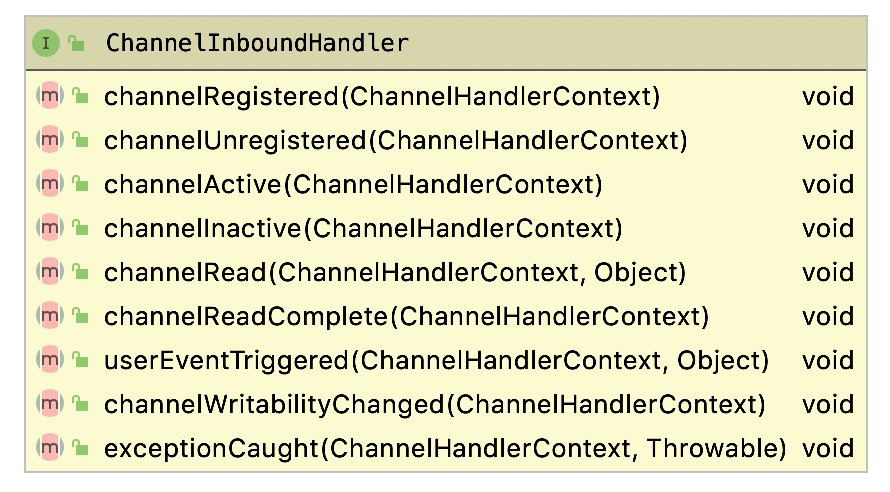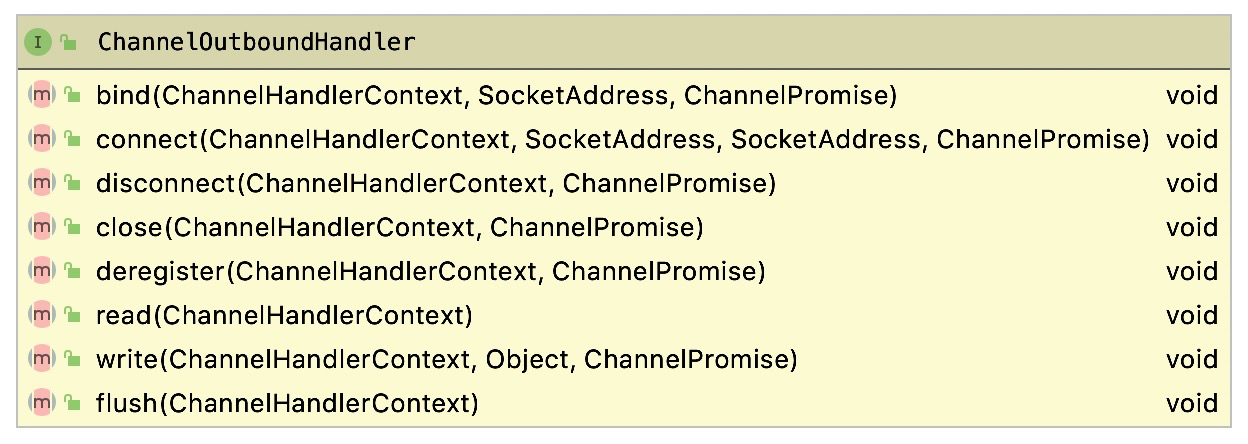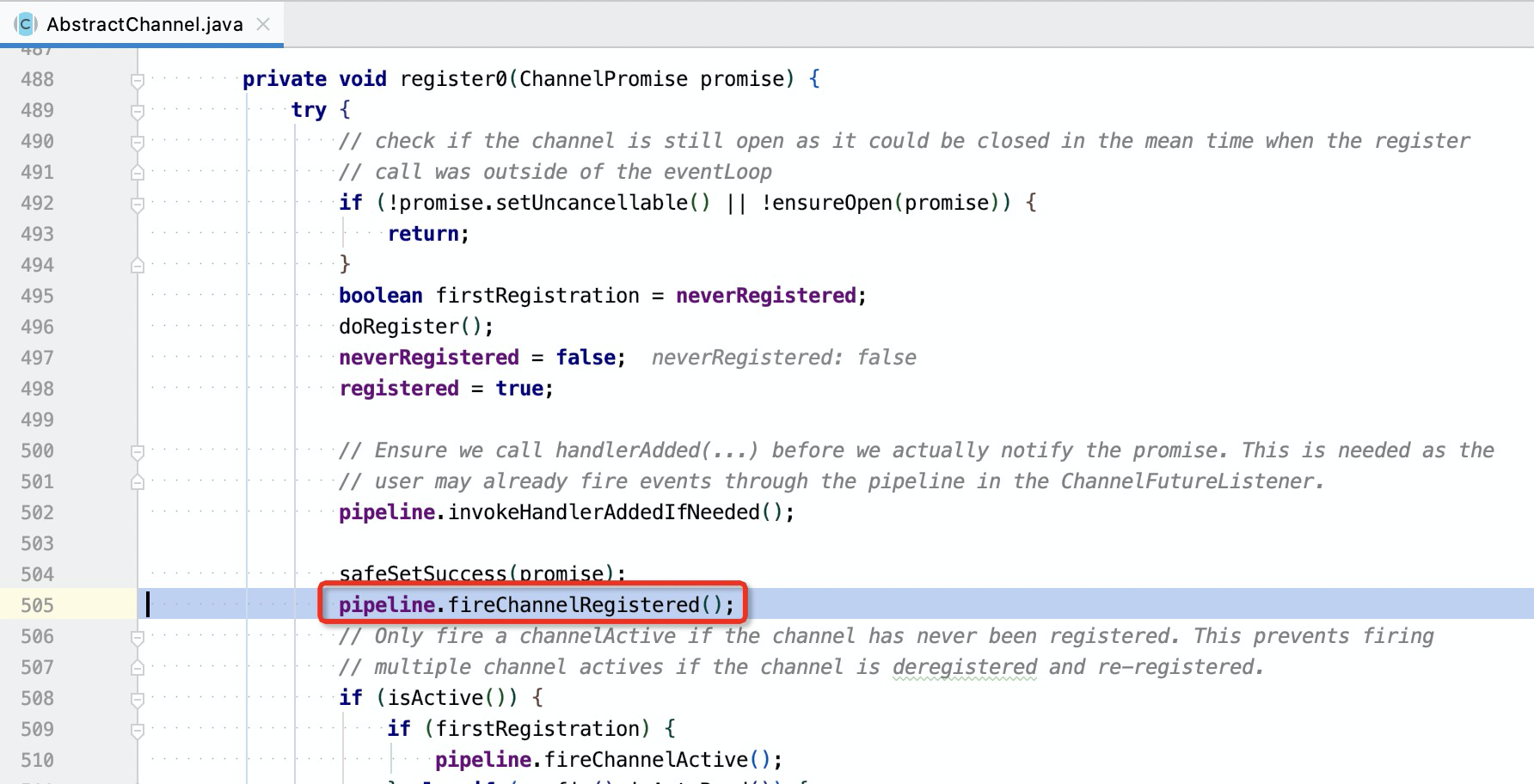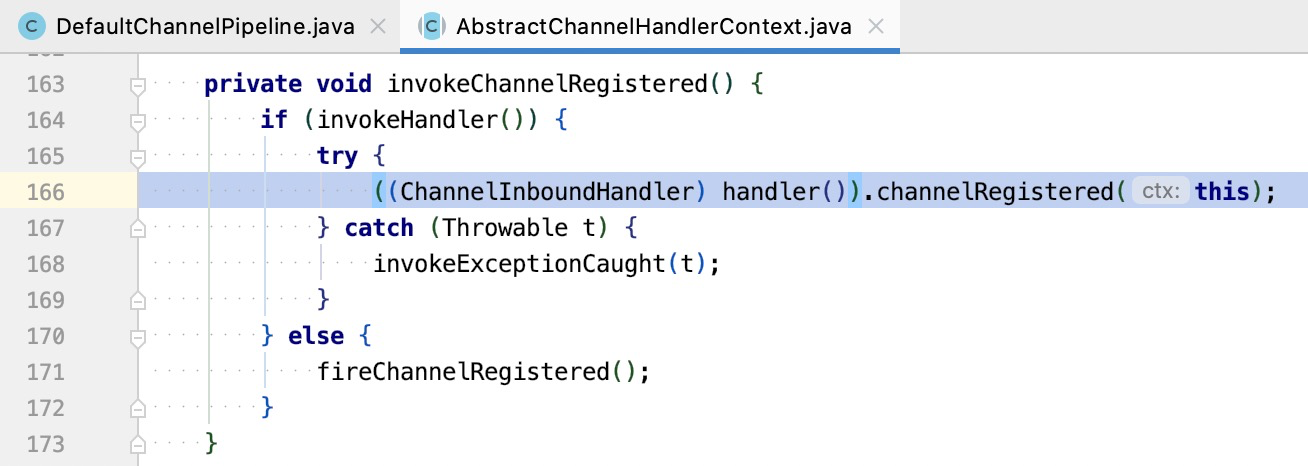事件在 pipeline 中传播时如何跳过非必须的 handler?
Netty 中通过在 pipeline 上添加各种 handler 组合来实现不同的逻辑,handler 又可以分为 ChannelInboundHandler 和 ChannelOutboundHandler,它们分别用于处理入站事件和出站事件。
下图所示是 ChannelInboundHandler 的方法列表,对应它支持处理的各种入站事件,例如 channelRegistered 用于处理 registered 事件

ChannelInboundHandler 处理的事件
同样地,ChannelOutboundHandler 提供了用于处理出站事件的方法,如下图所示,例如 bind 方法用于处理 channel 的绑定事件

ChannelOutboundHandler 处理的事件
因为每个 handler 有自己的职责,它可能并不关心所有的事件,而只关心自己感兴趣的事件。
当一个 pipeline 上添加的 handler 变多时,调用链路也会相应变长,这时就会引起一些问题。一方面调用栈会比较深,事件处理过程中占用内存增多;另一方面调用耗时也会增加。如果 handler 不关心某些事件,只是做向后或向前传播,这种情况下如果能跳过这些 handler,则会使得实际的调用链路变短,起到很好地优化效果。
Netty 中使用 @Skip 注解标志是否要跳过该事件的处理,例如 ChannelInboundHandlerAdapter 中对 ChannelInboundHandler 的实现均添加了 @Skip 注解,如下是其 channelRegistered 方法的实现
1 | /** |
如果自定义的 handler 继承了 ChannelInboundHandlerAdapter ,并且重写了 ChannelInboundHandler 提供的某个事件处理方法。当把它添加到 pipeline 上后,它只会处理重写过的方法对应的事件,不会参与其他事件的处理。
Skip 注解是如何生效的呢?
以 ChannelRegistered 事件为例,当 channel 完成注册之后,它会调用 DefaultChannelPipeline 的 fireChannelRegistered 方法传播 ChannelRegistered 事件。

ChannelRegistered 事件
fireChannelRegistered 的调用路径

DefaultChannelPipeline.fireChannelRegistered

AbstractChannelHandlerContext.invokeChannelRegistered(head)

head.invokeChannelRegistered()

head.channelRegistered

head.fireChannelRegistered
最终会调用到 head.fireChannelRegistered() 方法,这里可以分成两步来看
findContextInbound(MASK_CHANNEL_REGISTERED)用于找到下一个支持处理channelRegistered事件的InboundHandlerinvokeChannelRegistered用于调用该 handler 的channelRegistered方法
findContextInbound 的处理逻辑
findContextInbound 用于向后查找 pipeline 上的下一个符合条件的 InboundHandler,它的代码如下
1 | // AbstractChannelHandlerContext#findContextInbound |
它的入参是一个 mask,用于代表 ChannelInboundHandler 或 ChannelOutboundHandler 的不同方法,例如这里的 MASK_CHANNEL_REGISTERED 代表的是 ChannelInboundHandler 的 channelRegistered 方法
skipContext 用于判断是否要跳过 handler 所在的 handlerContext,它的代码如下
1 | // AbstractChannelHandlerContext#skipContext |
注意 (ctx.executionMask & mask) == 0 这段代码,其中 ctx.executionMask 表示对应的 handler 的 mask 值, mask = MASK_CHANNEL_REGISTERED 表示 channelRegistered 方法。如果两者进行与运算结果为 0,就说明该 handler 需要跳过 mask 对应的方法,即跳过 channelRegistered 方法。
当 HeadContext 调用 findContextInbound(MASK_CHANNEL_REGISTERED) 时,它的作用是从当前 ChannelHandlerContext 也就是 HeadContext 开始,往后找下一个不需要跳过 channelRegistered 方法的 ChannelHandlerContext 。
ctx.executionMask 的计算
直接看代码
1 | AbstractChannelHandlerContext(DefaultChannelPipeline pipeline, EventExecutor executor, |
可以看到是通过 ChannelHandlerMask 的 mask0 方法计算的,它的代码如下:
1 | private static int mask0(Class<? extends ChannelHandler> handlerType) { |
以 ChannelInboundHandler 的 channelRegistered 处理为例,mask 的初始值为 MASK_EXCEPTION_CAUGHT |= MASK_ALL_INBOUND,表示所有的 InboundHandler 方法,如果需要跳过某个方法,则将对应的二进制位置位 0
1 | mask &= ~MASK_CHANNEL_REGISTERED |
~MASK_CHANNEL_REGISTERED 用于对 MASK_CHANNEL_REGISTERED 的二进制位取反,也就是说将非目标位全部置位 1。然后和 mask 值进行按位与运算,其结果就是将目标位置位 0
再来看下 isSkippable 的代码
1 | private static boolean isSkippable( |
它会查找 channelHandler 上的指定方法,判断是否包含 @Skip 注解,若包含该注解,则说明需要跳过。
mask0 对所有的 InboundHandler 方法和 OutboundHandler 方法进行处理,得出一个最终结果,作为该 handler 的 mask 值。
- 2021-02-05
netty 中每个 channel 都会绑定了一个 pipeline,当有入站事件或出站操作时,会由 pipeline 中的 handler 进行拦截处理。
- 2021-04-14
Netty server 在启动过程中会触发一系列的 Inbound 事件,它的流程是怎样的呢?
- 2021-02-26
对于一个 Netty client 来说,在配置好
Bootstrap之后,通过调用其connect方法来连接到远程服务端,如下所示1
2
3
4Bootstrap b = new Bootstrap();
b.group(group)
...
ChannelFuture f = b.connect(HOST, PORT).sync(); - 2021-02-05
netty 是一个基于异步事件驱动实现的网络编程框架,它的内部使用了大量的异步编程方法,这是它性能高效的一个原因,但同时也使得代码阅读起来更加困难,本文就尝试分析下它的启动过程
- 2021-01-26
ServerBootstrap 启动时需要初始化 ServerSocketChannel 并将其绑定到 EventLoop 上,用于处理该 channel 上产生的各种事件。那么 ServerSocketChannel 是如何完成创建和初始化的?又是如何绑定到 EventLoop 上的?
预览: